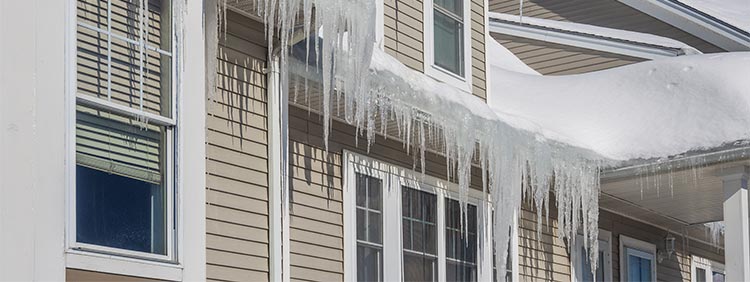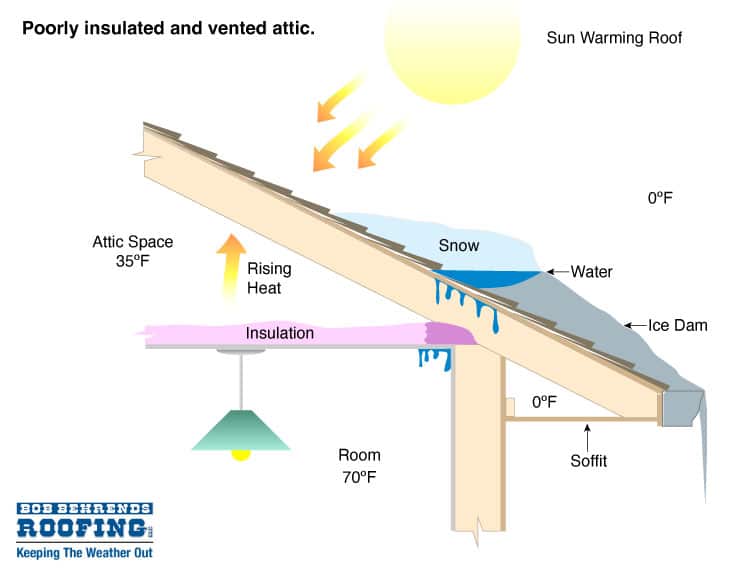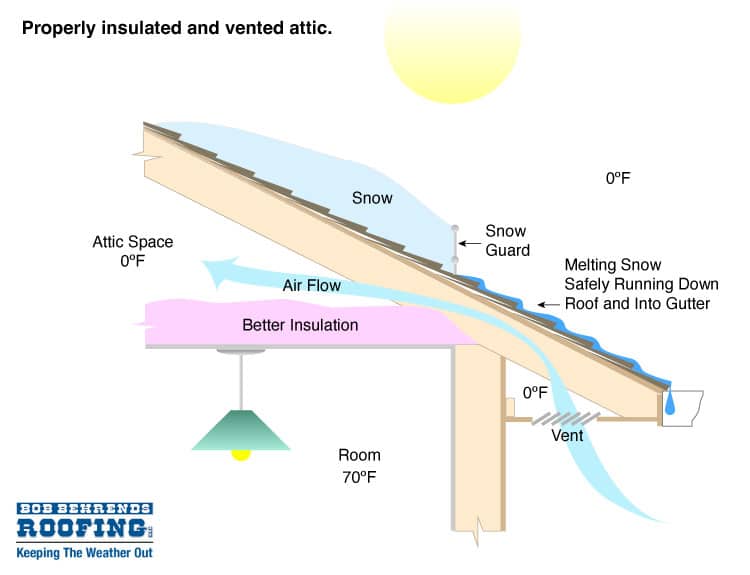An ice dam on a roof can potentially cause a lot of damage, and cost you a lot of money. Falling ice can cause injury to someone below. A falling gutter from excessive ice can cause serious injury or property damage. They can also cause damage to the roof. What’s more, melting water held back from the dam can seep into your home or building and cause extensive damage. The good news is, ice dams can be avoided.

In this article, you’ll learn:
Simply put, an ice dam on a roof is a dam made of ice. They typically occur above the soffit. The soffit is the area of your roof that extends past exterior walls of the house. Soffits are behind and underneath gutters. An ice dam prevents melting snow from reaching the gutter and draining away from the building or home.
What Causes an Ice Dam
The cause of ice dams is twofold: A build-up of snow on the edge of the roof above the soffit, and poor attic insulation and ventilation. Imagine a roof has several inches of snow on it. As warm air from inside the house warms the roof from below, and as the sun warms the roof from above, the snow melts and runs down the roof beneath the snow. When this water meets the freezing temperature of the roof above the soffit, it freezes and builds-up. This is the ice dam.

Do They Cause Problems
Ice dams definately can cause problems. Steep-sloped roofing materials, such as cedar shake and asphalt shingles, are not manufacturered to hold-up to standing water. They’re manufactured to allow water to run down them. Water has a way of finding vulnerabilities in your roof, such as broken seams or holes. As water sits on the shingles, it seeps in between any unsealed shingles it can. When the water that’s now in between the shingles freezes, it expands. This pushes the shingles further apart.
If there are any holes or gaps in the roof deck, the melting water will find it. Once the water is in your attic, additional problems are inevitable. Water in the attic will encourage mold growth, and can cause electric shorts and fires. Inside the home, a water leak can also cause an electric fire. A water leak from above can stain your ceiling. Wood studs, and ceiling and floor joists will swell and rot.
Ice dams can also damage gutters and anything beneath them. Gutters can crack and bend from the build-up of ice in them. Gutters also can break away from the home or building, causing damage to the building itself. Under enough weight from ice, gutters can completely fall off of a structure, resulting in extensive repairs, and bodily injury and further property damage to anything below.
How To Prevent an Ice Dam
To prevent an ice dam, it’s best to make sure the attic has adequate insulation and ventilation, and install a snow guard or snow fence up the roof above the soffit area. See illustration. A properly insulation and vented attic allows for the cold air outside to circulate through the attic without a loss of heat from inside the home or building. This also prevents the roof from getting warm as a result of rising heat from rooms inside the house.
A snow guard or snow fence holds snow back and allows the snow that’s over the soffit area to melt from the sun and drain away.
With an adequately ventilated and insultated attic, the roof deck shouldn’t get warm enough to melt the snow from below. Cold air outside is allowed to flow through the soffit and into the attic. With sufficient insulation in the attic, the home remains energy efficient.

Do Snow Guards Cause Ice Dams
No. Snow guards do not cause ice dams. In fact, the opposite is true. Snow guards help prevent them. With snow guards, and a properly vented and insulated attic, ice dams are preventable. When the snow above the soffit area melts away from the sun’s heat, snow guards hold snow further up the roof from sliding down the roof. As a result, what’s below the snow guard is exposed roof.
What about above the snow guard? No. Again, with sufficient attic insulation and adequate ventilation, excessive heat from inside the home can not penetrate the insulation, therefore, it can not warm the roof from below. A vented attic allows for the flow of cold air outside to circulate through the attic.
